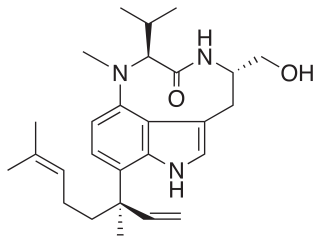Common Toxins Produced by Cyanobacteria, Dinoflagellates, and Diatoms
A wide variety of taxa can produce toxins in fresh and marine waters. This page compiles and summarizes information on common toxins produced by cyanobacteria, dinoflagellates, and diatoms. Summaries are provided for common toxins that include their chemical structure, congeners, taxa known to produce each, mode of action, bioaccumulation potential, and human health impacts. Methods for toxin detection and measurement can be found in:
Common Toxins Made by Cyanobacteria
Microcystins

Microcystins are a group of monocyclic heptapeptides, characterized by two variable amino acids in the X and Y positions. They are the most common cyanobacterial toxin with over 200 known congeners. Microcystin-LR (MC-LR, L for leucine and R for arginine) is the most well-known form.
Microcystins are produced by a variety of cyanobacteria, including members of Dolichospermum (previously Anabaena), Fischerella, Gloeotrichia, Nodularia, Nostoc, Oscillatoria, Microcystis, and Planktothrix. They exist in both particulate (in cells) and dissolved forms in drinking and recreational water sources and bioaccumulate in common aquatic vertebrates and invertebrates such as zooplankton, mussels, and fish. Further, they can bioaccumulate in aquatic plants and inhibit growth and photosynthesis, in addition to causing general oxidative stress.
Microcystins are hepatotoxins that primarily affect the liver; however, there is evidence showing additional impact on the kidney and reproductive systems. Although there is evidence linking microcystin-LR with both liver and colorectal cancers through tumor promotion, the EPA has determined that there is inadequate information to assess carcinogenic potential of microcystins in humans. This is primarily due to the limitations in available human studies (i.e., potential co-exposure to other contaminants) and lack of long-term animal studies evaluating cancer following oral exposure. Additional human impacts include oxidative stress, immunotoxicity, and genotoxicity.
- More information about human health effects
Cylindrospermopsin and Analogs

Cylindrospermopsin is a tricyclic guanidine alkaloid (C15H21N5O7S). It is produced by species of cyanobacteria including Aphanizomenon, Dolichospermum (previously Anabaena), Microseira (previously Lyngbya), Raphidiopsis (previously Cylindrospermopsis), and Umezakia. Currently, there are several analogs, including 7-epi-cylindrospermopsin, 7-deoxy-cylindrospermopsin, 7-deoxy-desulfo-cylindrospermopsin, and 7-deoxy-desulfo-12-acetylcylindrospermopsin.
Based on previous mouse studies, the primary toxic effects occur to the liver and kidney; however, cylindrospermopsin can also increase cellular stress, influence developmental processes, and lead to DNA damage. Additional studies have further characterized this toxin to be a protein synthesis inhibitor. This toxin has been shown to bioaccumulate in both aquatic invertebrates and vertebrates, posing a greater risk for commercial and recreational fishing. Unfortunately, there is currently inadequate information to assess the carcinogenic potential of cylindrospermopsin.
- For more information about health effects
Anatoxin-a, Homoanatoxin-a, and Natural Analogs

Anatoxins are secondary, bicyclic amine alkaloids (C10H15NO), and neurotoxins that bind to neuronal nicotinic acetylcholine receptors affecting the central nervous system. Cyanobacteria genera known to produce this toxin include Cylindrospermum, Chrysosporum (previously Anabaena), Cuspidothrix, Dolichospermum (previously Anabaena), Microcystis, Oscillatoria, Planktothrix, Phormidium, Raphidiopsis (previously Cylindrospermopsis), Tychonema, and Woronichinia. There are multiple analogs, including anatoxin-a, homoanatoxin-a, and dihydroanatoxin, with anatoxin-a being the most common. Anatoxins primarily cause serious neurologic distress with signs ranging from loss of coordination to death due to respiratory failure. Originally, anatoxin-a was referred to as “very fast death factor” due to the rapid mortality of animals after ingestion. Further, there is information to suggest that anatoxins also bioaccumulate in various aquatic invertebrates and vertebrates. There is no information available on the carcinogenicity of anatoxin-a in humans or animals or on potential carcinogenic precursor effects.
- For more information regarding human health effects of anatoxin-a

Guanitoxin (formerly known as Anatoxin-a(S))
Guanitoxin, or Anatoxin-a(S), is a phosphorylated cyclic N-hydroxyguanidine (C7H17N4O4P), naturally occurring organophosphate, and neurotoxin that irreversibly inhibits acetylcholinesterase (AChE). It is typically produced by species of cyanobacteria including Dolichospermum (previously Anabaena). Since guanitoxins are neurotoxic, symptoms include convulsions, fasciculation, hypersalivation, and in more serious circumstances, death by respiratory arrest. Currently, there is limited information to assess Guanitoxin’s carcinogenicity.
Nodularin

Nodularin is produced by cyanobacteria including species of Nodularia or Nostoc that primarily thrive in salt or brackish waters. Several (~10) congeners for nodularin exist, with nodularin-r being the most common. Like microcystin, nodularins impact the liver and are characterized as hepatotoxins; however, they also cause overall oxidative stress. Exposure primarily occurs from contaminated water; however, bioaccumulation in aquatic invertebrates and vertebrates can occur and lead to additional potential risk.

Lyngbyatoxin
Lyngbyatoxin, is an alkaloid with the chemical formula C27H39N3O2, produced by cyanobacteria including Moorea producens (formerly Lyngbya majuscula). Lyngbyatoxins are tumor promotors from competitive binding to protein kinase C (PKC). Exposure typically results in acute dermatitis or “swimmer’s itch”, eye, or respiratory irritation. Since it is a tumor promotor, Lyngbyatoxin is categorized as carcinogenic.
Saxitoxins

Saxitoxins are representative of a large toxin family referred to as the Paralytic Shellfish Poisoning (PSP) toxins. These toxins are produced from marine dinoflagellates including Alexandrium, Gymnodinium, and Pyrodinium and by freshwater cyanobacteria including species of Aphanizomenon, Dolichospermum (previously Anabaena), Microseira (previously Lyngbya), Planktothrix and Raphidiopsis. Saxitoxins are primarily neurotoxic. Exposure leads to blockage of sodium gated channels and membrane depolarization preventing transmission of action potential. Potential symptoms range from minor tingling and numbness to death from respiratory failure. Exposure to marine saxitoxins typically occurs through ingestion of contaminated shellfish. No information is available on the carcinogenicity of saxitoxins.
Beta-Methylamino-L-alanine

Beta-Methylamino-L-alanine (BMAA) is a non-protein amino acid with a chemical formula of C4H10N2O2. It is produced by various species of cyanobacteria (i.e., Nostoc and Anabaena), diatoms (i.e., Thalassiosira sp. and Achnanthes sp.), and dinoflagellates (i.e., Heterocapsa triquetra and Gymnodinium catenatum). Exposure to BMAA causes neurotoxicity due to intraneuronal protein misfolding and can occur through the ingestion of contaminated shellfish. Effects range from convulsions to hypothesized increased risks for neurological diseases like ALS (amyotrophic lateral sclerosis) later in life. Currently there is no information to identify BMAA as a carcinogen.
Lipopolysaccharide Endotoxins (LPS)
Lipopolysaccharide Endotoxins (LPS) exist in the outer membrane of Gram-negative bacteria and are comprised of three main components: Lipid A, O-antigen, and a core polysaccharide. The chemical formula is C211H376N8O126P6 . Cyanobacterial species that produce LPS include Microcystis aeruginosa, Anabaena flos-aquae, Anacystis nidulans, and several others. Potential effects range from skin rashes to gastrointestinal or respiratory issues. Although, more information is needed to fully understand the potential health implications from cyanobacterial LPS. No information is currently available on LPS carcinogenicity.
Common Marine Toxins Made by Dinoflagellates
Brevetoxin

Produced by Karenia brevis or “red tide”, brevetoxins are polycyclic polyethers, usually a variation of one of two structures (Structure A=C49H70O13 , Structure B=C50H70O14), that cause Neurotoxic Shellfish Poisoning (NSP). Brevetoxins are similar to ciguatoxins, but smaller in structure size. They are neurotoxins whose mode of action includes depolarization of the open voltage-gated sodium ion channels located in cell walls, eventually leading to increased sodium ions in the cell. The most common route of exposure is through oral ingestion of contaminated shellfish. Further, brevetoxins can be found in mollusks and fish that are non-filter feeders; although ingestion of these organisms typically does not cause neurotoxic shellfish poisoning because the toxins tend to bioaccumulate in inedible fatty organs. Symptoms associated with exposure include gastrointestinal issues (vomiting, diarrhea, abdominal pain), muscular pain, and potential loss of motor control with respiratory distress. Currently, there is no direct evidence of brevetoxin linked to carcinogenicity.
Ciguatoxin

Ciguatoxins are polycyclic polyethers produced by Gambierdiscus toxicus, a small marine dinoflagellate, that typically grows on and around coral reefs. Bioconcentration does occur as dinoflagellates are consumed by herbivorous fish, which are later consumed by humans, where the toxins cause Ciguatera Poisoning (CP). Symptoms of exposure include gastrointestinal (e.g., nausea, diarrhea, etc.), joint or muscle pain, fatigue, and numbness or tingling of fingers, toes, or mouth. No information is available to indicate ciguatoxin is carcinogenic.
Azaspiracid

Azaspiracids (AZA) are polycyclic ether marine toxins with the chemical formula C47H71NO12 that cause Azaspiracid Shellfish Poisoning (AZP). They are produced by the dinoflagellates, Amphidona and Azadinium spinosum. Theses toxins inhibit endocytosis of plasma membrane proteins, considered cytotoxic, and can impact intracellular signaling molecules that are important for variety of internal pathways. AZA can accumulate in various shellfish, increasing potential exposure. Human consumption of contaminated shellfish can lead to severe nausea, diarrhea, and vomiting. Further studies are needed to identify the carcinogenic potential of this toxin.
Okadaic acid/Dinophysistoxin

Okadaic Acid is a polyether toxin with the chemical formula C44H68O13. It is typically found in the dinoflagellates Dinophysis and Thorecta. This toxin induces apoptosis and is a potent inhibitor of serine/threonine phosphatases. Okadaic Acid tends to accumulate in marine sponges and shellfish. Exposure typically occurs from the ingestion of shellfish.
Symptoms primarily include gastrointestinal known as Diarrhetic Shellfish Poisoning (DSP). There is evidence to suggest that Okadaic Acids are potent tumor promotors; however, more evidence is still needed to confirm carcinogenicity.
Common Marine Toxins Made by Diatoms
Domoic Acid

Domoic Acid (DA) causes Amnesic Shellfish Poisoning (ASP). It is a heterocyclic amino acid produced by Pseudo-nitzchia (Chemical formula: C15H21NO6). It acts as an agonist to glutamate receptors inducing membrane depolarization in Na+ ion channels, which eventually leads to cell death. Crustaceans, fish and shellfish are capable of accumulating elevated levels of domoic acid without apparent ill effects. Human ingestion of contaminated shellfish can lead to initial symptoms of gastroenteritis, followed by varying neurologic symptoms (e.g., dizziness, motor weakness, seizures, etc.). Further information is needed to determine DA’s carcinogenic potential.
Tabular Information on Toxins and Associated Taxa
Common Toxins and Associated Taxa
Toxin Group | Toxin Produced | Example Toxin Producing Species |
|---|---|---|
Anatoxins | Anatoxin-a | Anabaena sp., Aphanizomenon sp., Arthrospira fusiformis, Cuspidothrix issatschrnkoi, Raphidiopsis mediterranea (strain LBR148), Cylindrospermum sp., Dolichospermum flos-aquae, Dolichospermum macrosporum, Dolichospermum mendotae, Dolichospermum planctonicum, Dolichospermum spiroides, Microcoleus autumnalis, Oscillatoria sp., Phormidium cf. uncinatum, Phormidium favosum, Phormidium sp., Pseudanabaena, Tychonema variabilis |
Homoanatoxin-a | Blennothrix lyngbyacea, Raphidiopsis mediterranea (strain LBR148), Oscillatoria sp., Phormidium cf. uncinatum, Phormidium formosum | |
Azaspiracids | Azaspiracid | Amphidoma languida, Azadinium dexteroporum, Azadinium poporum, Azadinium spinosum |
Ciguatoxins | Ciguatoxin | Gambierdiscus toxicus |
Cylindrospermopsins | Cylindrospermopsins | Anabaena lapponica, Aphanizomenon gracile, Aphanizomenon flos-aquae, Aphanizomenon ovalisporum, Cylindrospermopsis raciborskii, Dolichospermum mendotae, Anabaena planctonica, Lyngbya wollei, Oscillatoria sp. (PCC-6407, -6506, -7936, -10702), Raphidiopsis curvata, Raphidiopsis mediterranea |
Deoxy-cylindrospermopsin | Cylindrospermopsis raciborskii, Lyngbya wollei, Raphidiopsis curvata, Raphidiopsis mediterranea | |
7-epi-cylindrospermopsin | Oscillatoria sp. (PCC-6407, -6506, -7936, -10702) | |
Microcystins | Microcystin | Anabaena sub-cylindrica (benthic), Anabaena sp., Anabaenopsis arnoldi, Anabaenopsis milleri, Annamia toxica, Aphanocapsa cumulus, Arthrospira fusiformis, Calothrix parietina, Anabaena circinalis, Anabaena flos-aquae, Anabaena flos-aquae f. lemmermannii (NIVA-CYA 83/1), Fischerella sp., Geitlerinema sp., Haplosiphon hiberniscus (soil extract strain), Plectonema boryanum (benthic), Leptolyngbya sp., Limnothix sp., Merismopedia sp., Microcystis aeruginosa, Microcystis bengalensis, Microcystis botrys, Microcystis flos-aquae, Microcystis ichthyoblabe, Microcystis novacekii, Microcystis panniformis, Microcystis pseudofilamentosa, Microcystis ramosa, Microcystis viridis, Nostoc spongiaeforme (benthic), Nostoc sp. (freshwater), Nostoc sp. (lichen associate), Nostoc sp. (benthic), Nostoc sp. (symbiont strains), Oscillatoria limosa (benthic), Oscillatoria tenuis, |
Nodularins | Nodularin | Nodularia sphaerocarpa (PCC7804), Nodularia spumigena, Nostoc sp. (symbiont strains) |
Okadaic acid | Okadaic acid | Dinophysis acuminata, Dinophysis acuta, Dinophysis caudata, Dinophysis fortii, Dinophysis infundibula, Dinophysis mils, Dinophysis norvegica, Dinophysis ovum, Dinophysis sacculus, Dinophysis tripos |
Saxitoxins | Saxitoxin | Aphanizomenon gracile, Aphanizomenon flos-aquae, Aphanizomenon issatschenkoi, Anabaena circinalis, Anabaena lemmermannii, Aphanizomenon sp. (strains NH-1, NH5, DC-1), Cylindrospermopsis raciborskii, Geitlerinema amphibium, Geitlerinema lemmermannii, Hydrocoleum sp., Lyngbya wollei, Lyngbya robusta, Limnothrix redekei, Phormidium sp., Scytonema cf. crispum, Trichodesmium erythraeum, |
Taxa Producing Less Common Toxins
Taxa | Toxin Produced | Toxicity Description |
|---|---|---|
Prymnesium parvum (“Golden Algae”) | Believed to produce a number of toxins, including prymnesins
| Ichthyotoxic; Known to damage the permeability of gill cells, altering their ability to exchange water and absorb oxygen |
Cochlodinium fulvescens (“Rust Tide”) | Toxins have not been directly identified | Ichthyotoxic |
Fibrocapsa japonica | Produces hemolysin | Ichthyotoxic and inducer of oxidative stress |
Gymnodinium catenatum | Produces Saxitoxin and analogues | Neurotoxic |
Heterosigma akashiwo | Potentially produces brevetoxins | Ichthyotoxic |
Ostreopsis spp. | Produces palytoxin and analogues (e.g., otreocins, ovatoxins, mascarenotoxins) | Palytoxins disrupt Na+, K+, -ATPase pump |
Pfiesteria piscicida and Pfiesteria shumwayae | Toxins have not been isolated and identified | Toxicity is due to carbon-sulfur-metal based radical production |
Prorocentrum spp. | Produce uncharacterized neurotoxin; other strains may produce okadaic acid and/or dinophysistoxin | Can lead to neurotoxicity, or diarrhetic shellfish poisoning |
Takayama | No specific toxins have been identified | Ichthyotoxic |
Toxin Detection and Identification Techniques
Type of Identification Technique | Technology/ Technique used | Toxins Identified | |
|---|---|---|---|
Analytical | Liquid chromotography with fluorescence detection | HPLC and HPLC-FLD | Anatoxin-a, Ciguatoxins, Cylindrospermopsins, Domoic Acid, Microcystins, Nodularins, Okadaic acid/dinophysistoxins, and Saxitoxins |
Liquid chromotography with mass spectrometry | LC-MS, LC-MS/MS | Anatoxin-a, Azaspiracids, Brevetoxins, Ciguatoxins, Cylindrospermopsins, Domoic Acid, Microcystins, Nodularins, Okadaic acid/dinophysistoxins, and Saxitoxins
| |
Gas chromatography with mass spectrometry | GC-MS | Anatoxin-a | |
Capillary electrophoresis or liquid chromatography with UV spectroscopy | CE-UV, HPLC-UV | Anatoxin-a, Brevetoxins, Ciguatoxins, Cylindrospermopsins, Domoic Acid, Microcystins, and Nodularins | |
In vivo | Whole organism toxicity | Insect/invertebrate assay and rodent bioassay | Anatoxin-a, Brevetoxins, Cylindrospermopsins, Microcystins, Nodularins, Okadaic acid/dinophysistoxins, and Saxitoxins |
In vitro | Antibodies | Bead-based assay (i.e., Luminex), ELISA, and lateral flow assays | Anatoxin-a, Azaspiracids, Brevetoxins, Ciguatoxins, Cylindrospermopsins, Domoic acids, Microcystins, Nodularins, Okadaic acid/dinophysistoxins, and Saxitoxins |
Cellular based assays (plate) | Cytotoxicity assays, electron microscopy, and light microscopy | Azaspiracids, Brevetoxins, Ciguatoxins, Microcystins, Nodularins, Okadaic acid/dinophysistoxins, and Saxitoxins | |
Enzymatic activity | Enzyme inhibition assay (plate) | Anatoxin-a, Brevetoxins, Microcystins, Nodularins, and Okadaic acid/dinophysistoxins | |
Pharmacological receptor | Receptor binding assay (plate) | Anatoxin-a, Brevetoxins, Ciguatoxins, Domoic Acid, and Saxitoxins, | |
Guidance Values for Cyanotoxins Outside the United States
Guidance values, standards, or other national regulations/recommendations for oxins in drinking or surface waters outside the US.
Toxin | Authority | Drinking Water (μg/L) | Recreational Water (μg/L) |
|---|---|---|---|
Anatoxin-a | Australia, RWQMP (Low level) | - | <3 |
Australia, RWQMP (Medium level) | - | ≥3 | |
Australia, RWQMP (High level) | - | ≥10 | |
Australia, RWQMP (Extreme level) | - | ≥25 | |
Italian National Group for CRMWHC | 20 | - | |
New Zealand PMAV (Homoanatoxin-a) | 6 | - | |
Quebec PMAV, Canada | 3.7 | - | |
WHO Guideline Values (provisional) | 30 | 60 | |
Cylindrospermopsin | Australia | 1.0 | - |
Brazil | 15 | - | |
WHO Guideline Value (provisional) | 0.7 (long-term); 3 (short-term) | 6 | |
Microcystin | Australia (Microcystin-LR) | 1.3 | - |
Australia (Total Microcystins) | - | ≥10 | |
Brazil (Microcystin-LR) | 1 | - | |
Canada (Microcystin-LR) | 1.5 | 20 | |
Czech Republic (Microcystin-LR) | 1 | - | |
Denmark (Microcystin-LR) | 1 | - | |
Finland (Microcystin-LR, Raw water) | >1 | - | |
Finland (Microcystin-LR, Finished water) | >10 |
| |
France (Microcystin-LR) | 1 | - | |
Germany (Microcystin-LR) | 1 | - | |
Italy (Microcystin-LR) | 1 | - | |
Japan (Microcystin-LR) | 1 | - | |
Korea (Microcystin-LR) | 1 | - | |
Netherlands (Microcystin-LR) | 1 | - | |
Norway (Microcystin-LR) | 1 | - | |
New Zealand (Microcystin-LR) | 1 | - | |
Poland (Microcystin-LR) | 1 | - | |
South Africa (Microcystin-LR) | 1 | - | |
Spain (Microcystin-LR) | 1 | - | |
Turkey | 1 | <10 | |
Uruguay | 1 | - | |
WHO Guideline Value (provisional) | 1 (long-term); 12 (short term) | 24 | |
Saxitoxin | Brazil |
|
|
New Zealand PMAV | 1 | - | |
WHO Guideline Value (provisional) | 3 | 30 | |
Nodularin | New Zealand PMAV | 1 | - |
Guanitoxin | New Zealand PMAV | 1 | - |
Guidance Values, Standards, or other national regulations/recommendations for cyanotoxins in seafood
Toxin | Authority | Value |
|---|---|---|
Anatoxin | California, USA | 1100 ng/g wet weight |
Azaspiracids | EU | 16 ug/ 100 g of shellfish meat |
Cylindrospermopsin | California, USA | 66 ng/g wet weight |
Victoria, Australia | 18-39 ug/kg whole organism | |
Microcystin | California, USA | 10 ng/g wet weight |
France (children) | 1.4 ug/kg fish tissue | |
France (adults) | 5.6 ug/kg fish tissue | |
Victoria, Australia | 24-51 ug/kg whole organism | |
Saxitoxin | Victoria, Australia | 800 ug/kg whole organism |
